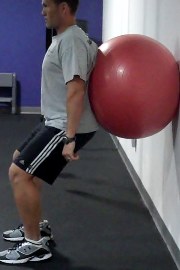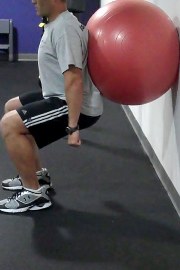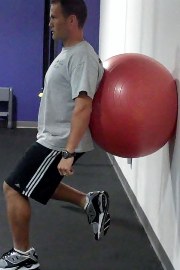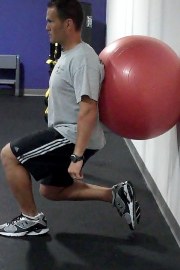
Brian Schiff's Functionally Fit takes a new step - or, more appropriately, a bend - into a new miniseries. This time, he takes a look at exercises that help training one of the most troublesome parts of the body: the infamous knee.
See 'Related Resources' below for past Functionally Fits and other exercises and training tips.
Execution
Using a stability ball against the wall, perform isometric holds at multiple angles for five to 30 seconds, based on client tolerance. Avoid bouncing, and make sure the knees do not extend beyond the toes.
Perform one to 10 repetitions at each angle, depending on hold time. I typically advocate working up to 30 total seconds at each angle (one to three times). Typical angles may include 30, 45, 60, 75 and 90 degrees.
 |  |
| (Shallow Wall Sit) | (Deeper Wall Sit) |
You may go lower if indicated for functional activities, but know that compression on the patella-femoral joint rises sharply after 90 degrees.
Application
This is an excellent way to strengthen the quadriceps in those clients suffering from patello-femoral knee pain or knee arthritis. It is important to identify exactly what range of motion creates knee pain. Then you should work to strengthen the knee above and below this range as indicated. Since the exercise is isometric, you avoid shear force and minimize compressive activity, particularly when above 60 degrees of flexion.
A few other tips:
- This is an excellent way to work into traditional squats without increasing knee pain.
- You may add dumbbells to increase load.
- Lengthen the hold time to maximize recruitment and time under tension.
- For advanced clients, you may progress to single-leg wall sits as well, but be cautious of fatigue and stability at lower angles.
 |  |
| (Shallow Single-leg Wall Sit) | (Deeper Single-leg Wall Sit) |
Additional Notes
This exercise can be done without a stability ball; however, I find the ball allows the client to focus on proper knee alignment without the fear of sliding down the wall itself. It also allows for a more precise incremental change in the flexion angle, thereby allowing the trainer to make more subtle changes on response to client pain.
Brian Schiff, PT, CSCS (www.brianschiff.com) is a licensed physical therapist, respected author and fitness professional. He became a Certified Strength and Conditioning Specialist (CSCS) in 1998. In 2000, he opened his own personal training and sport-specific conditioning facility, Fitness Edge, in Dublin, Ohio. Brian has presented at several professional conferences and seminars on injury prevention and sport-specific training.















